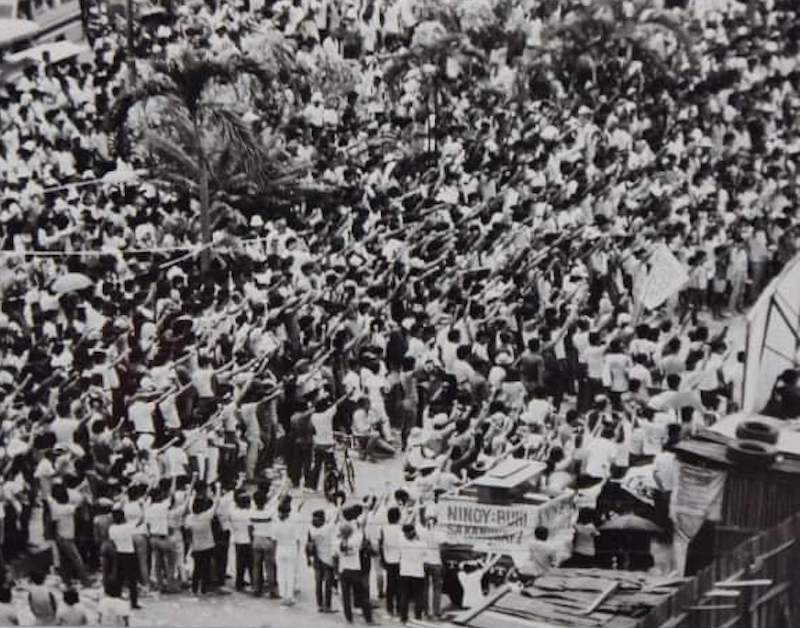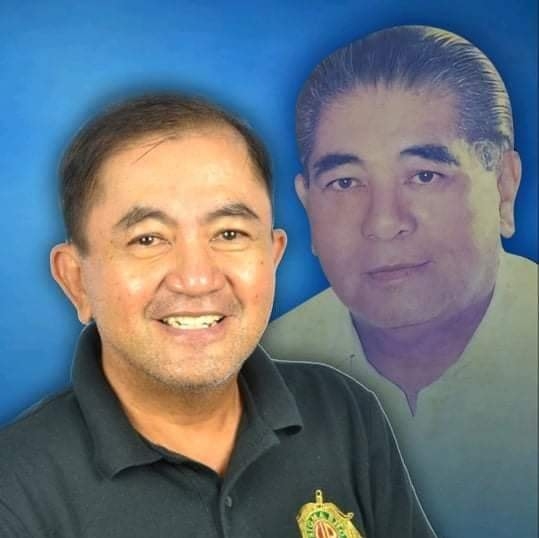1st of three parts
DAVAO CITY (MindaNews / 15 May) — Coming out of the Marco Polo Hotel’s 17th floor after meeting with Senator Benigno Simeon Aquino III on September 3, 2009, Rodrigo Roa Duterte, then ending his sixth term as city mayor, told reporters that Aquino, like him, is “also a child of destiny.”
Senator Mar Roxas was supposed to run for President under the Liberal Party in the May 2010 polls but the death on August 1, 2009 of Aquino’s mother, Corazon, who was catapulted to the Presidency by People Power in 1986, made him a more viable candidate than Roxas. Aquino’s father, Benigno Jr., was assassinated on August 21, 1983 upon arrival at the airport from his three-year exile in the United States, his murder sparking outrage and protests nationwide that escalated and hastened the downfall of the dictator Ferdinand Edralin Marcos.
“I am a child of destiny. I never wanted to be a mayor,” Duterte said.

“If you believe in God, you believe in destiny. I was happy being a prosecutor until one day, I was yanked out of my position and was appointed (OIC) vice mayor,” he told reporters that day in September 2009.
Duterte was referring to his unexpected entry into the political arena when the dictator Marcos was ousted by People Power in February 1986.
He was one of the city’s prosecutors when prosecutors were still referred to as “Fiscal.”
Duterte was appointed Fiscal in 1977 on the recommendation of Elias Baguio Lopez, a friend of his late father, Vicente who was Governor of the then undivided Davao from 1959 to 1965. Vicente’s widow, Soledad had approached Lopez for help to ensure her son would land a job at the City Fiscal’s Office.
Lopez and the Governor were members of the Nacionalista Party (NP).
According to Earl Ferrer’s book, “Beyond Will and Power,” Lopez proposed the creation of a new post – Special Counsel for Political and Military Affairs – under the Davao City Fiscal’s Office. That proposal was approved by Marcos and the Justice Secretary then appointed Duterte to that post.
By then, Duterte had been married four years to Elizabeth Zimmerman and their firstborn, Paolo, was two years old.
Yellow Friday Movement
Duterte’s father served the Cabinet of Marcos as Secretary of General Services from December 30, 1965 until he resigned in 1967 to run for Congressman representing Davao del Sur under NP. But the party junked him in favor of Councilor Artemio Loyola who was proclaimed by Marcos as the NP’s official candidate in a rally in Davao City. Vicente ran as an independent candidate but lost. He died of cardiac arrest in February 1968.
After the assassination of former Senator Benigno Aquino, Jr. on August 21, 1983, Soledad, then a very influential civic leader, joined the Jesuit priest, Rudy Malasmas, in organizing the Yellow Friday Movement in Davao City. Every Friday, confetti rained on the main streets of Davao City during marches or motorcades against the Marcos dictatorship.
Fiscal Duterte would remain in his regular-paying job at the prosecutor’s office. In May 1985, he joined briefly a group of lawyers staging a picket in front of City Hall, raising their fists in protest of the arrest and detention of human rights lawyers Laurente Ilagan, Antonio Arellano and Marcos Risonar.
On the night of February 25, 1986, when Marcos was ousted by People Power and flown out of Malacanang with his family, Duterte, who was turning 41 the following month, woke up his children Paolo and Sara to join fellow Dabawenyos and the rest of the nation in celebrating their first night of freedom.

“I was playing in dreamland when my father interrupted my slumber and told me to get dressed because we have to go downtown. While we were huddled in the car, he told us, ‘Timan-i ninyo ning gabhiona ni. Ayaw ninyo kalimti’ (Remember this night. Do not ever forget),” recalled his daughter Sara in a statement on February 24, 2017, in reaction to a letter written by Lingayen-Dagupan Archbishop Socrates Villegas on the 31st commemoration of the EDSA People Power.
Sara was turning 8 in May 1986 and Paolo, 11 by March.
The uprising that ousted the dictator Marcos gave rise to the political career of Rodrigo Roa Duterte, that would span three decades in Davao City, the last six years as President of the Philippines. He was the second lawyer-President after Marcos, the second city mayor (Estrada was the first) to become President but while Estrada moved from San Juan to the Senate and the Vice Presidency before becoming President, Duterte went directly form mayor to President.
Plucked out from obscurity by destiny, as he would often say, Duterte became OIC Vice Mayor from 1986 to 1987 and by 1988 began his uninterrupted political presence in Davao City: elected mayor for three three-year terms from 1988 to 1998; representative of the 1st congressional district from 1998 to 2001; mayor again for three terms from 2001 to 2010; vice mayor to daughter Sara from 2001 to 2013; and mayor again from 2013 to 2016.
In 2016, Duterte was elected the country’s 16th President, the first Mindanawon to lead the country.
Destiny would manifest itself in the sudden turn of events in Duterte’s life, consistently as a substitute: substitute for his mother as OIC Vice Mayor, substitute for Martin Dino as the PDP-Laban’s Presidential candidate, and substitute for the mayoralty that he held for 22 years across seven terms.
Destiny and Elias Lopez
Destiny – and Elias Lopez — played a hand in Duterte’s political career after his stint as OIC Vice Mayor.
Duterte was not supposed to be the candidate of the Marcos remnants in the city – Alejandro Almendras, Sr. and Manuel Garcia of the pre-EDSA Kilusang Bagong Lipunan (KBL) of Ferdinand Marcos, Sr.
Almendras and Garcia had stayed with Marcos and vigorously campaigned for the then already sickly dictator, bringing him to Davao City for a rally in the run-up to the February 7, 1986 snap Presidential elections against challenger Corazon Cojuangco Aquino. A toilet had to be constructed on the rally stage for the ailing President at the PTA Grounds (now People’s Park).
Almendras and Garcia lost their power and influence, albeit temporarily, when People Power ousted the Marcoses. Nationwide, a new set of leaders emerged from out of the resistance movement against Marcos, aside from traditional politicians who cast their lot with the Cory Aquino – Salvador Laurel tandem.
Lopez, who was not a KBL member but an NP member, was actually the choice of Almendras and Garcia to run for mayor of Davao City in 1988.
Lopez, a Bagobo who graduated from the University of the Philippines College of Law, served as councilor, vice mayor and as mayor from 1967 to 1971 and 1981 to 1986. He was the mayor when the EDSA People Power unfolded. (In post-EDSA politics, he would serve as the city’s 3rd district Representative from 1992 to 1995, was reelected for the term 1995 to 1998 but passed away in 1997. In the 1998 elections, his lawyer-son, Ruy Elias, would run for Representative of the 3rd district).
“Nawalan ng kandidato”
Ruy Elias Lopez, who ran for mayor against Sara Duterte until she opted to run for Vice President and was substituted by youngest brother Sebastian, the incumbent vice mayor, recalled in an interview with MindaNews, this crucial meeting in the house of Garcia sometime in late 1987.
Lopez’ father had earlier declined the offer of Almendras and Garcia to run for mayor, citing his double heart bypass as reason.
Almendras and Garcia, along with his father, agreed on Dominador “Boy” Zuno, who was a councilor of the city from 1972 to 1986.

In 1987, Luis Santos, who was the KBL candidate for mayor in 1981 (he lost to Lopez), resigned as Representative of the 3rd district when President Cory Aquino appointed him Local Governments Secretary in October 1987 (the first post-EDSA election was for Congress in 1987).
Santos and Zafiro Respicio, the OIC Mayor of Davao City, were both candidates for mayor in 1981 – Santos under KBL, Respicio under Laban ni Ninoy — and Elias Lopez under NP. Lopez won that election.
Santos and Respicio would later become allies in the ruling party.
Ruy says Santos got wind of the Almendras-Garcia plan to pit Zuno against Respicio for mayor in the 1988 polls and offered Zuno to be the Vice Mayor of Respicio.
Zuno was expected in the meeting in Garcia’s house that night to firm up the line-up of candidates so they could file the certificates of candidacy, Ruy recalls.
Zuno was a no-show. The Almendras-Garcia camp learned that same night that Zuno had said yes to Santos’ offer to be Respicio’s running mate. “Nawalan na sila ng kandidato” (they lost a candidate), Ruy said.
“Mag-file ka for mayor”
Before that meeting in Garcia’s house, Rodrigo Duterte, grateful for Lopez’ help in facilitating his appointment at the City Fiscal’s Office, was among those who went to the house of Lopez to express support and volunteer help if he would run for mayor in 1988, just two years after Marcos was ousted.
Duterte was in the meeting at Garcia’s house.

Ruy remembers his dad telling Almendras “wala tayong kandidato” (we have no candidate) and Almendras responding “Pre, hindi pwede walang kalaban yan. We must put up a candidate. Lalaban dapat tayo. Hindi natin pwedeng palampasin walang kalaban yan.”
“So my father understood the logic ni Almendras … Finally, my father said, ‘ako may kandidato,’ tapos sabi nila ‘o meron palang kandidato ‘Pre. Sino? Sino?’ Scraping from the bottom of the barrel na sila (Almendras) eh. Not my father. Father ko, tahimik lang” (he was quiet).
Ruy said his father called Duterte. “Rudy, halika” (Rudy, come here).
“Sa Monday, punta ka ng Comelec. Mag file ka for mayor,” Lopez told Duterte.
Duterte’s response, according to Ruy, was: “Sir, ako, Mayor?” to which his father replied, “hindi ba abogado ka? Dapat marunong ka mag file. File ka Monday” (aren’t you a lawyer? You should know how to file. File on Monday).
“That’s how it happened,” Ruy said.
Almendras and Garcia, according to Ruy, did not find Duterte a viable candidate.
He said his father “sensed that Almendras and Garcia were not keen on Duterte being the candidate but they had no choice because they did not have a candidate to present.”
Asked if his father told him why he endorsed Duterte, Ruy replied he did not . “But I can surmise that he was convinced by Almendras that they must field a candidate, that since Almendras cannot present one and that the fact that Digong (Rodrigo Duterte) is the son of Dad’s political ally, Governor Vicente Duterte, my Dad endorsed Digong knowing clearly that he had to literally carry Digong’s candidacy to beat Respicio.”
He said this was the reason why “my father had to personally campaign in all the barangays of the entire Davao City (for Duterte) while Almendras and Garcia were dragging their feet in the campaign.” The former mayor of Davao City would become Duterte’s mentor in the art of campaigning for mayor.
Lopez, who facilitated Duterte’s entry into the City Fiscal’s Office, would facilitate Duterte’s entry to City Hall where he would end up as the longest-serving mayor in the history of Davao City. (Carolyn O. Arguillas / MindaNews)
Tomorrow: “Utang kabubot-on”
0 Comments